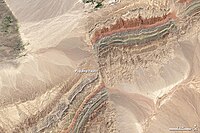
Photo from wikipedia
On July 20, 2017 22:31 UTC, a strong Mw = 6.6 earthquake occurred at shallow depth between Kos Island (Greece) and Bodrum (Turkey). We derive a co-seismic fault model from joint inversion… Click to show full abstract
On July 20, 2017 22:31 UTC, a strong Mw = 6.6 earthquake occurred at shallow depth between Kos Island (Greece) and Bodrum (Turkey). We derive a co-seismic fault model from joint inversion of geodetic data (GNSS and InSAR) assuming that the earthquake can be modelled by the slip of a rectangular fault buried in an elastic and homogeneous half-space. The GNSS observations constrain well most of the model parameters but do not permit to discriminate between south- and north-dipping planes. However, the interferograms, produced from C-band ESA Sentinel 1 data, give a clear preference to the north-dipping plane. We also map surface motion away from the satellite along the Turkish coast (from Bodrum towards the east) which reached about 17 cm onshore islet Karaada. The best-fit model is obtained with a 37° north-dipping, N283°E striking normal fault, in agreement with the published moment tensor solutions. The resolved slip vector is dominantly normal with a slight component of left-lateral motion (15°). The surface projection of the seismic fault outcrops in the Gökova ridge area, a well-developed bathymetric feature inside the western Gulf of Gökova. Our geodetic model fits the pattern of the shallow, north-dipping aftershocks obtained from rigorous relocation of all available recordings in the region (about 1120 events; relocated mainshock is at 36.955°N, 27.448°E; depth at 9.2 km ± 0.5 km). The relocated aftershocks also indicate clustering at both ends of the rupture and seismicity triggering mainly towards the east and the north, within 2 weeks following the mainshock. We also analysed regional GPS data (interseismic velocities) and obtained an extension rate of 3.2 mm/yr across the Gökova rift, along a direction N165°E.
Journal Title: Pure and Applied Geophysics
Year Published: 2019
Link to full text (if available)
Share on Social Media: Sign Up to like & get
recommendations!